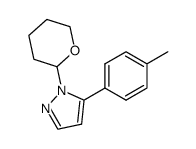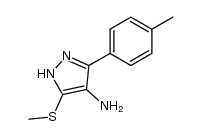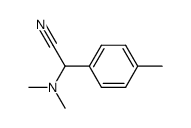3-(4-Methylphenyl)-1H-pyrazole

3-(4-Methylphenyl)-1H-pyrazole structure
|
Common Name | 3-(4-Methylphenyl)-1H-pyrazole | ||
|---|---|---|---|---|
| CAS Number | 59843-75-3 | Molecular Weight | 158.200 | |
| Density | 1.1±0.1 g/cm3 | Boiling Point | 343.9±11.0 °C at 760 mmHg | |
| Molecular Formula | C10H10N2 | Melting Point | 82-86ºC | |
| MSDS | N/A | Flash Point | 162.4±12.2 °C | |
| Name | 5-(4-methylphenyl)-1H-pyrazole |
|---|---|
| Synonym | More Synonyms |
| Density | 1.1±0.1 g/cm3 |
|---|---|
| Boiling Point | 343.9±11.0 °C at 760 mmHg |
| Melting Point | 82-86ºC |
| Molecular Formula | C10H10N2 |
| Molecular Weight | 158.200 |
| Flash Point | 162.4±12.2 °C |
| Exact Mass | 158.084396 |
| PSA | 28.68000 |
| LogP | 2.68 |
| Vapour Pressure | 0.0±0.7 mmHg at 25°C |
| Index of Refraction | 1.591 |
Synonym:None Section 2 - COMPOSITION, INFORMATION ON INGREDIENTS
Risk Phrases: None Listed. Section 3 - HAZARDS IDENTIFICATION EMERGENCY OVERVIEW
The toxicological properties of this material have not been fully investigated. Potential Health Effects Eye: May cause eye irritation. Skin: May cause skin irritation. Ingestion: May cause irritation of the digestive tract. The toxicological properties of this substance have not been fully investigated. Inhalation: May cause respiratory tract irritation. The toxicological properties of this substance have not been fully investigated. Chronic: No information found. Section 4 - FIRST AID MEASURES Eyes: Flush eyes with plenty of water for at least 15 minutes, occasionally lifting the upper and lower eyelids. Get medical aid. Skin: Get medical aid. Flush skin with plenty of water for at least 15 minutes while removing contaminated clothing and shoes. Wash clothing before reuse. Ingestion: Never give anything by mouth to an unconscious person. Get medical aid. Do NOT induce vomiting. If conscious and alert, rinse mouth and drink 2-4 cupfuls of milk or water. Inhalation: Remove from exposure and move to fresh air immediately. If not breathing, give artificial respiration. If breathing is difficult, give oxygen. Get medical aid. Notes to Physician: Section 5 - FIRE FIGHTING MEASURES General Information: As in any fire, wear a self-contained breathing apparatus in pressure-demand, MSHA/NIOSH (approved or equivalent), and full protective gear. During a fire, irritating and highly toxic gases may be generated by thermal decomposition or combustion. Extinguishing Media: Use agent most appropriate to extinguish fire. Use water spray, dry chemical, carbon dioxide, or appropriate foam. Section 6 - ACCIDENTAL RELEASE MEASURES General Information: Use proper personal protective equipment as indicated in Section 8. Spills/Leaks: Clean up spills immediately, observing precautions in the Protective Equipment section. Sweep up or absorb material, then place into a suitable clean, dry, closed container for disposal. Provide ventilation. Section 7 - HANDLING and STORAGE Handling: Wash thoroughly after handling. Use with adequate ventilation. Avoid contact with eyes, skin, and clothing. Keep container tightly closed. Avoid ingestion and inhalation. Storage: Store in a tightly closed container. Store in a cool, dry, well-ventilated area away from incompatible substances. Section 8 - EXPOSURE CONTROLS, PERSONAL PROTECTION Engineering Controls: Use adequate ventilation to keep airborne concentrations low. Exposure Limits CAS# 59843-75-3: Personal Protective Equipment Eyes: Wear appropriate protective eyeglasses or chemical safety goggles as described by OSHA's eye and face protection regulations in 29 CFR 1910.133 or European Standard EN166. Skin: Wear appropriate protective gloves to prevent skin exposure. Clothing: Wear appropriate protective clothing to prevent skin exposure. Respirators: A respiratory protection program that meets OSHA's 29 CFR 1910.134 and ANSI Z88.2 requirements or European Standard EN 149 must be followed whenever workplace conditions warrant respirator use. Section 9 - PHYSICAL AND CHEMICAL PROPERTIES Physical State: Powder Color: white Odor: Not available. pH: Not available. Vapor Pressure: Not available. Viscosity: Not available. Boiling Point: Not available. Freezing/Melting Point: 82-86 C Autoignition Temperature: Not applicable. Flash Point: Not applicable. Explosion Limits, lower: Not available. Explosion Limits, upper: Not available. Decomposition Temperature: Solubility in water: Specific Gravity/Density: Molecular Formula: C10H10N2 Molecular Weight: 158.20 Section 10 - STABILITY AND REACTIVITY Chemical Stability: Stable at room temperature in closed containers under normal storage and handling conditions. Conditions to Avoid: Incompatible materials, excess heat. Incompatibilities with Other Materials: Oxidizing agents. Hazardous Decomposition Products: Carbon monoxide, oxides of nitrogen, irritating and toxic fumes and gases, carbon dioxide. Hazardous Polymerization: Has not been reported Section 11 - TOXICOLOGICAL INFORMATION RTECS#: CAS# 59843-75-3 unlisted. LD50/LC50: Not available. Carcinogenicity: 3-(4-Tolyl)pyrazole - Not listed by ACGIH, IARC, or NTP. Section 12 - ECOLOGICAL INFORMATION Section 13 - DISPOSAL CONSIDERATIONS Dispose of in a manner consistent with federal, state, and local regulations. Section 14 - TRANSPORT INFORMATION IATA Not regulated as a hazardous material. IMO Not regulated as a hazardous material. RID/ADR Not regulated as a hazardous material. Section 15 - REGULATORY INFORMATION European/International Regulations European Labeling in Accordance with EC Directives Hazard Symbols: Not available. Risk Phrases: Safety Phrases: S 24/25 Avoid contact with skin and eyes. S 28A After contact with skin, wash immediately with plenty of water. S 37 Wear suitable gloves. S 45 In case of accident or if you feel unwell, seek medical advice immediately (show the label where possible). WGK (Water Danger/Protection) CAS# 59843-75-3: No information available. Canada None of the chemicals in this product are listed on the DSL/NDSL list. CAS# 59843-75-3 is not listed on Canada's Ingredient Disclosure List. US FEDERAL TSCA CAS# 59843-75-3 is not listed on the TSCA inventory. It is for research and development use only. SECTION 16 - ADDITIONAL INFORMATION N/A |
|
~86% 
3-(4-Methylphen... CAS#:59843-75-3 |
| Literature: Gerard, Anne-Laure; Bouillon, Alexandre; Mahatsekake, Clement; Collot, Valerie; Rault, Sylvain Tetrahedron Letters, 2006 , vol. 47, # 27 p. 4665 - 4669 |
|
~9% 
3-(4-Methylphen... CAS#:59843-75-3 |
| Literature: Journal of the Chemical Society, Perkin Transactions 1: Organic and Bio-Organic Chemistry (1972-1999), , p. 1945 - 1950 |
|
~% 
3-(4-Methylphen... CAS#:59843-75-3 |
| Literature: Chemistry of Heterocyclic Compounds, , vol. 38, # 6 p. 668 - 676 |
|
~% 
3-(4-Methylphen... CAS#:59843-75-3 |
| Literature: Synthesis, , # 6/7 p. 690 - 691 |
|
~% 
3-(4-Methylphen... CAS#:59843-75-3 |
| Literature: Synthesis, , # 6/7 p. 690 - 691 |
|
~% 
3-(4-Methylphen... CAS#:59843-75-3 |
| Literature: Synthesis, , # 6/7 p. 690 - 691 |
|
~% 
3-(4-Methylphen... CAS#:59843-75-3 |
| Literature: Journal of Organic Chemistry, , vol. 70, # 19 p. 7530 - 7536 |
|
~% 
3-(4-Methylphen... CAS#:59843-75-3 |
| Literature: Synlett, , vol. 1997, # 8 p. 959 - 961 |
| Precursor 3 | |
|---|---|
| DownStream 0 | |
| MFCD00665963 |
| 3-(4-Methylphenyl)-1H-pyrazole |
| 1H-Pyrazole, 3-(4-methylphenyl)- |
| 3-p-tolylpyrazole |
| 1H-Pyrazole, 5-(4-methylphenyl)- |
| 5-p-Tolyl-1H-pyrazole |
| 5-(4-Methylphenyl)-1H-pyrazole |








